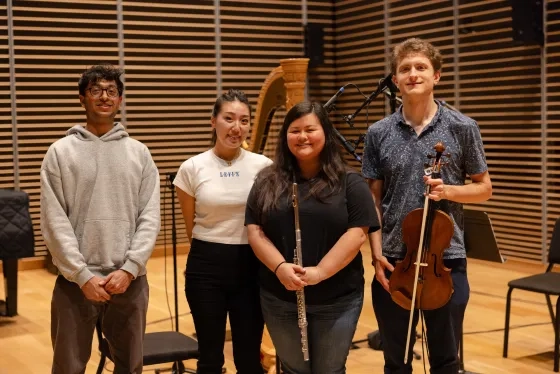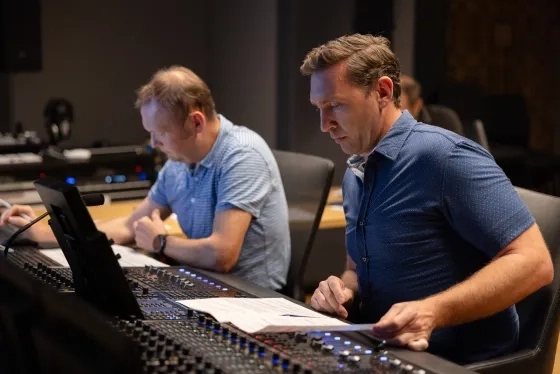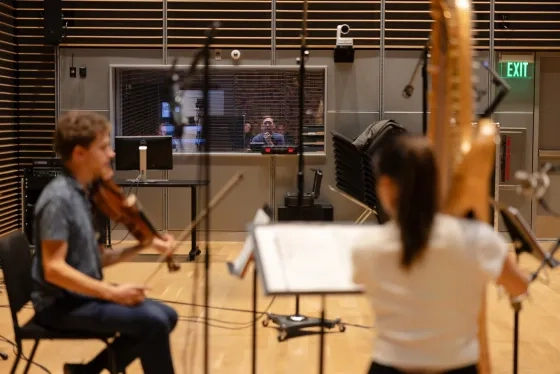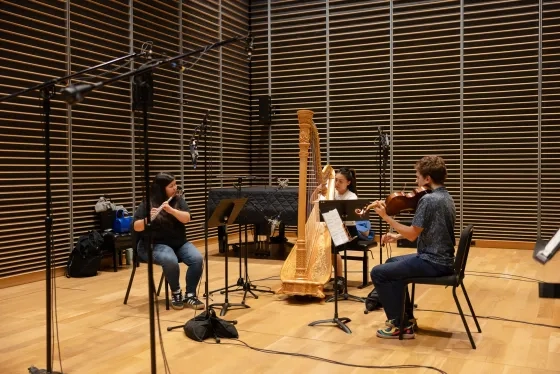2025's KDFC Sound Logo Winners on Their Paths to the Airwaves
Ansh Patel and Aaron Pike are this year's winners of the annual collaboration between SFCM and KDFC Classical California, which sees students compose sound logos for KDFC’s airwaves.
On the face of things, Ansh Patel and Aaron Pike took very different paths to getting their original compositions played on the radio, but it was at SFCM and the Technology and Applied Composition Department (TAC) that those paths converged.
Patel and Pike are this year's winners of KDFC Classical California and the SFCM TAC Department's ongoing Sound Logo collaboration. The competition sees TAC students submit original compositions to be judged by faculty and KDFC, with the winning works being used as the radio stations' sound logos (station-identifying interstitials between programs). The works may be short, but KDFC's reach extends as far north as Ukiah, as far south as Monterey, and as far east as Livermore, meaning at least 200 miles of California listeners hear them.
The pair's different backgrounds illustrate the diversity of the TAC Department. Patel majored in computer science as an undergrad, and, after years of making his own beats on his laptop, decided to enroll in TAC's Professional Studies Certificate program, an accelerated one-year track that focuses specifically on industry-standard technologies and professional composition workflows. But, as he says, "one year went by way too fast," and he enrolled in the TAC master's program.
"I didn't expect to get into this style of composition when I got here," Patel says, "but obviously while the program is very heavily focused on film and game scoring, there's a big classical music element to that I've been learning about. I just tried to figure out if I could write music with that sort of sound, and it was really fun to do."
Pike, meanwhile, received his master's degree in composition from SFCM, studying with department Chair David Conte and re-enrolled this year in the TAC department—while continuing to teach in SFCM's Pre-College program. "I've been working in music since I graduated from the Conservatory back in 2011," Pike says. "I also teach privately and I've been writing music for different projects along the way as well, so juggling work and being a student this year has been very overwhelming at times."
Pike adds that thanks to his time with Conte, he's confident in the strictly compositional side of his work. "But there's a lot to learn on the software side and technology side that I knew a little about but wasn't super well-versed in beforehand. I composed this piece by hand; none of it was done "in the box.' And that's why I went back to school this year: to learn more about the production side, the digital world and DAWs (digital audio workstations) and how to produce "in the box.'" Despite the demanding schedule, Pike says, his time in TAC so far "has been good. It's shown me that I can get quite a bit accomplished in a short amount of time if I put my mind to it."
Patel, meanwhile, felt similarly intimidated moving from beat-making to the complex rules of Western music theory. "Sometimes I'll write things and the harmonies won't make traditional sense, so I'll run them by my friends. But it's been a cool challenge, even if it takes me longer to do even short compositions like this; it helps me in the other types of music I want to make."
Both compositions were recorded in SFCM's state-of-the-art Studios G and H with fellow students. "When you're composing like I do," Patel says, "You can lose touch with how it's going to sound when real, serious musicians are playing it. So every time I've been able to do a live recording session of something here, it's been really illuminating to see how different and cool a human interpretation of my music can be."
"What's cool about the TAC program," he continues, "where there's a lot of film and game scoring, is that you can try to move away from those like really strict harmony rules. There's a little more flexibility about like, "If it sounds good, it is good.'"
The KDFC sound logo collaboration will celebrate its 10th year in 2026. "It wasn't simply an exercise of who was the best composer, but who could create something in the format requested by the client," KDFC President Bill Lueth said in 2022. He sees the competition as a way to help students become the most well-rounded composers they can be: "Some will write music for movies and commercials, some might become doctors and lawyers and teachers, and who knows, some might even have a career in the radio business.
Learn more about studying Composition or Technology and Applied Composition at SFCM.





